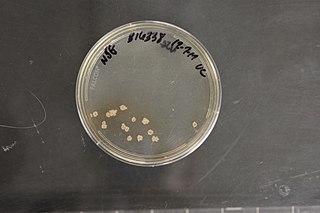
The Thermoproteota are prokaryotes that have been classified as a phylum of the Archaea domain. Initially, the Thermoproteota were thought to be sulfur-dependent extremophiles but recent studies have identified characteristic Thermoproteota environmental rRNA indicating the organisms may be the most abundant archaea in the marine environment. Originally, they were separated from the other archaea based on rRNA sequences; other physiological features, such as lack of histones, have supported this division, although some crenarchaea were found to have histones. Until recently all cultured Thermoproteota had been thermophilic or hyperthermophilic organisms, some of which have the ability to grow at up to 113 °C. These organisms stain Gram negative and are morphologically diverse, having rod, cocci, filamentous and oddly-shaped cells.

Amycolatopsis is a genus of high GC-content bacteria within the family Pseudonocardiaceae. The genus is known for producing many types of antibiotics, including

In taxonomy, the Methanosarcinaceae are a family of the Methanosarcinales.

Ensifer is a genus of nitrogen-fixing bacteria (rhizobia), three of which have been sequenced.
In taxonomy, Stygiolobus is a genus of the Sulfolobaceae.
In taxonomy, Rhodothalassium is a genus of the Rhodobacteraceae. Up to now there is only one species of this genus known.
In taxonomy, Rubrimonas is a genus of the Rhodobacteraceae.
In taxonomy, Sagittula is a genus of the Rhodobacteraceae.
Halobaculum is a genus of the Halorubraceae.
In taxonomy, Halogeometricum is a genus of the Haloferacaceae.
Natrinema is a genus of the Natrialbaceae.
Natronorubrum is a genus in the family Halobacteriaceae.

Amycolatopsis orientalis is a Gram-positive bacterium in the phylum Actinomycetota. It produces several substances with antimicrobial properties, including the antibiotic drug vancomycin.

The Glycomycetaceae are a family of bacteria.
Amycolatopsis rifamycinica is a species of Gram-positive bacteria in the genus Amycolatopsis. It produces the rifamycin antibiotics, which are used to treat mycobacterial diseases such as tuberculosis and leprosy. The type strain of Amycolatopsis rifamycinica has been reclassified several times. When it was first isolated from a French soil sample in 1957, it was identified as Streptomyces mediterranei. In 1969, the species was renamed Nocardia mediterranei because its cell wall was thought to resemble that of Nocardia species. The species was renamed Amycolatopsis mediterranei in 1986 after finding that it is not susceptible to Nocardia phage and has a cell wall that lacks mycolic acid. Finally, in 2004, it was determined that strain DSM 46095 represented a new species, independent of Amycolatopsis mediterranei, based on 16S ribosomal RNA sequencing. The new species was named Amycolatopsis rifamycinica.
Dietzia maris is a Gram-positive and aerobic bacterium from the genus Dietzia.
Cryobacterium is a Gram-positive and strictly aerobic bacterial genus from the family of Microbacteriaceae.
Tsukamurella is a Gram-positive, non-spore-forming, rod-shaped and obligate aerobic bacterial genus from the family of Tsukamurellaceae. Most of the strains of Tsukamurella degrade starch. Some Tsukamurella species can cause infections in humans.
The Coriobacteriia are a class of Gram-positive bacteria within the Actinomycetota phylum. Species within this group are nonsporulating, strict or facultative anaerobes that are capable of thriving in a diverse set of ecological niches. Gordonibacter species are the only members capable of motility by means of flagella within the class. Several species within the Coriobacteriia class have been implicated with human diseases that range in severity. Atopobium, Olsenella, and Cryptobacterium species have responsible for human oral infections including periodontitis, halitosis, and other endodontic infections. Eggerthella species have been associated with severe blood bacteraemia and ulcerative colitis.
Dermacoccus is a Gram-positive, non-spore-forming, chemoorganotrophic and aerobic genus of bacteria from the family of Dermacoccaceae.





